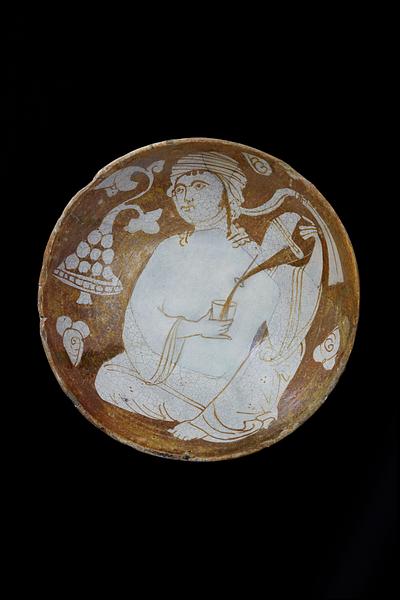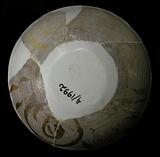Earthenware bowl, painted in lustre over a white glaze
Egypt; 11th – early 12th century
H: 5.5; Diam: 20.5 cm
While the motifs on figurative bowls painted in lustre in Abbasid Iraq were stylized, a number of quite naturalistic depictions of courtiers, dancers, wrestlers, etc. are known from Fatimid Egypt.
Here we have a young man in a long-sleeved tunic with a tiraz band and wearing an elaborately wound turban. He is pouring a dark drink, presumably wine, from a glass decanter into a beaker, which is a reconstruction, since the bowl is missing three shards. Beside him stands a dish with cakes or fruit from which a palmette grows.
There are many figurative elements in Fatimid art, something that should perhaps be seen in the context of the region’s Coptic Christian tradition.
Inv. no. 4/1992
Published in:
Emma Brunner-Traut, Hellmut Brunner, Johanna Zick-Nissen: Osiris, Kreuz und Halbmond: die drei Religionen Ägyptens, Mainz am Rhein 1984, cat.no. 199;
Kjeld von Folsach, Torben Lundbæk and Peder Mortensen (eds.): Sultan, Shah and Great Mughal: the history and culture of the Islamic world, The National Museum, Copenhagen 1996, cat.no. 120;
Kjeld von Folsach: Art from the World of Islam in The David Collection, Copenhagen 2001, cat.no. 129;
Sheila S. Blair and Jonathan M. Bloom (eds.): Cosmophilia. Islamic Art from the David Collection, Copenhagen, McMullen Museum of Art, Boston College, Boston 2006, cat.no. 10;
Kjeld von Folsach, Joachim Meyer: The Human Figure in Islamic Art – Holy Men, Princes, and Commoners, The David Collection, Copenhagen 2017, cat.no. 8;
Farzaneh Pirouz-Moussavi: Cerámica entre dos mares: De Bagdad a la talavera de Puebla = Clay between two seas: from Baghdad to the talavera of Puebla, Mexico 2017, p. 50;
Axel Langer (ed.): In the name of the image : Figurative representation in Islamic and Christian cultures, Museum Rietberg, Zürich, Berlin 2022, cat. 108, pp. 194-196, 199;


